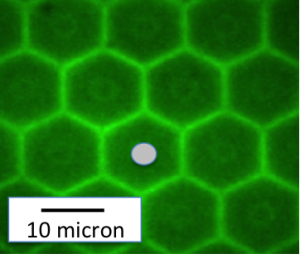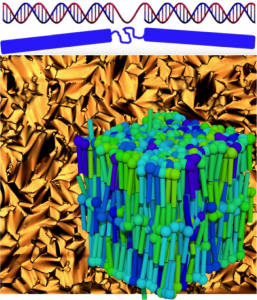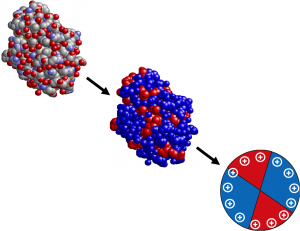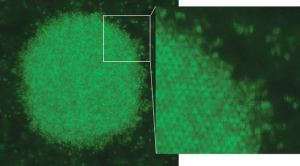Phase Behaviour
DNA-Based Materials
We study the phase behavior of suspensions of DNA-based molecules, which either consist of combinations of DNA fragments, or DNA in combination with synthetic colloids and polymers.
|
Direct visualization of conformation and dense packing of DNA-based soft colloids We introduce novel DNA-coated colloids with thick brushes of surface-grafted DNA (up to a thickness of 10 micron). These DNA-coated colloids allow the direct visualization of the internal brush structure and arm’s free-end locations with confocal fluorescent microscopy, as a function of grafting density, brush thickness, and ionic strength. The highly packed two-dimensional hexagonal lattice formed by these macromolecular assemblies reveal an unexpected resistance to mutual interpenetration of their charged corona at pressures approaching the MPa (see the figure). We also find that this lattice is surprisingly tolerant to particle size variation. These DNA-synthetic hybrids could aid to obtain a deeper insight in a wide range of problems in soft matter, including the study and design of biomimetic lubricated surfaces [1]. |
 Fluorescence image of a two-dimensional hexagonal packing with end-labeled DNA. The grey circular area indicates the size of the colloidal bead. |
|
A New Smectic Phase in Suspensions of DNA Duplexes Stiff, double stranded DNA fragments are know not to form a smectic phase. Introducing a single stranded spacer in the middle of a double stranded DNA, thus increasing flexibility, unexpectedly leads to the formation of a smectic phase. X-ray scattering and simulations show that the stiff parts of the duplexes reside within the same smectic layer (see the figure). We named this phase the “smectic-fA phase”, where the “f” stands for “folding” [2]. |
 Depolarized image of the morphology of the smectic-fA phase. The inset is a simulation snapshot showing folding of most of the duplexes. |
Proteins
The patchy interactions between proteins give rise to a phase behavior that is not found in relatively simple colloidal systems. We develop and apply theoretical methods that account for these patchy interactions on the basis of a minimal model for the pair-interaction potential, using advanced statistical physics tools, and we assess to what extent the simplifying theory can explain experimental observations and computer simulations.
|
Phase Behavior of Globular Proteins: Effects of Patchiness and Additives Solutions of globular proteins such as lysozyme and BSA have a rich equilibrium and non-equilibrium phase behaviour, triggered by competing attractive and repulsive interactions [1, 2] and the surface patchiness of the proteins. We have successfully analysed the phase behaviour and microstructure and dynamics [3, 4, 5] of protein solutions using colloid-based theoretical models, in comparison with experimental results and computer simulations. |
 Modeling lyzosyme proteins as patchy spherical colloids. |
Rod-Like Viruses
Filamentous viruses are used as model systems for very long and thin colloidal rods. The native viruses are highly charged, their charge density can be chemically modified, and they can be coated with quite thick polymer brushes. Moreover, the micron-sized length allows for imaging single particles. A variety of different viruses is used, with different persistence- and contour lengths.
|
Glass Transition in Suspensions of Very Long and Thin Colloidal Rods Suspensions of very long and thin rods (fd-virus particles) at low ionic strength (corresponding to a Debye length of 27 nm) exhibit a (Wigner) glass transition well within the chiral-nematic state. It is shown that at the glass-transition concentration, the single-particle dynamics is arrested, as well as the dynamics of the chiral-nematic orientational texture. The dynamics of the domain texture is probed by video time-correlation spectroscopy. The single-particle dynamics continuously slows down on approach of the glass transition by increasing the fd-concentration, while the time scale on which the domain texture freezes exhibits a discontinuity, as shown in the figure [1, 2]. |
 Initial image time-correlation decay rates as a function of fd-concentration. The images show the nematic morphology right after filling the sample cell and after 40 hours, just below the glass transition (upper two images) and just above (lower images). The radius of the images is 2 cm. |
| Rod-Sphere Mixtures
In most studies on phase diagrams of colloids, there is short range attraction and long range repulsion. What if it is the other way around? One of the very few ways to achieve long range attraction and short range repulsion is by using rods as depletants. Thus, we study the phase behavior of rod-sphere mixture for various size ratios and ionic strengths, exploiting the mono-disperse character of rod-like viruses, which exhibit a rich phase behavior such as a gas-liquid crystal coexistence (see the figure) [1] . |
 Three phase coexistence in rod-sphere mixtures: the core is crystalline while the surface of the droplet is liquid-like, and there are single beads in the background gas phase. |
